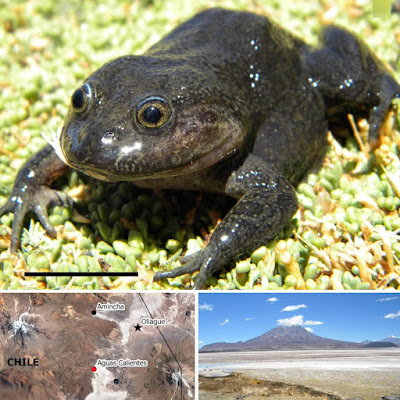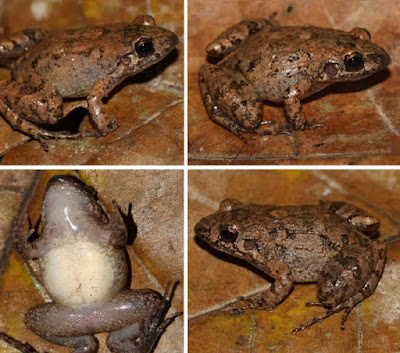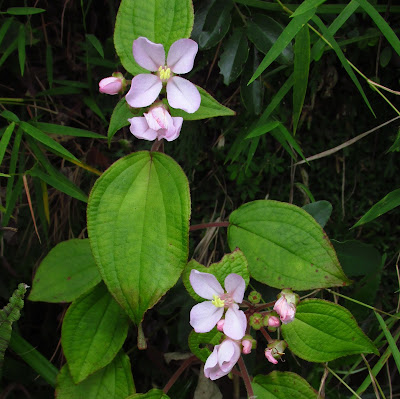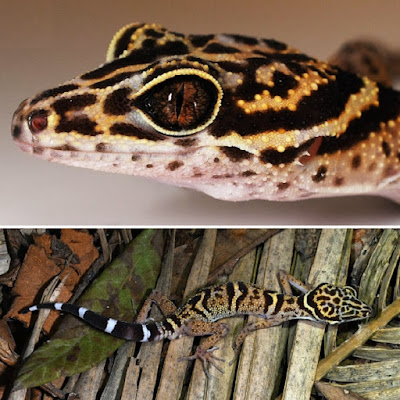[Most Recent Entries] [Calendar View]
Wednesday, September 16th, 2020
| Time | Event | ||||
| 3:23a | [Herpetology • 2020] Rediscovery of the Enigmatic Andean Frog Telmatobius halli Noble (Anura: Telmatobiidae), Re-description of the Tadpole and Comments on New Adult’s Characters, Type Locality and Conservation Status
Abstract We report the rediscovery of Telmatobius halli (Hall’s water frog), which had not been found since its description (over 80 years) since its type locality was not clearly established. “Aguas Calientes” near Ollagüe is hypothesized as the original type locality where Frank Gregory Hall collected the type material in 1935. The tadpole is re-described, and new data on the external and internal morphology of adults is provided. These new morphological data are compared with Telmatobius spp. inhabiting geographically close to T. halli in Chile and Bolivia. In addition, comments on its ecology, conservation, and taxonomic status in relation with other Telmatobius spp. inhabiting nearby areas in Ascotán and Carcote salt pans are provided. No evidence of Batrachochytrium dendrobatidis and Ranavirus infection was found in T. halli and a sympatric amphibian species. Our work supports the validity of T. halli and suggests this species should be considered as Data Deficient in the IUCN Red List assessment until taxonomic issues are resolved. Keywords: Amphibia, Taxonomy, Telmatobius, aquatic frog, type locality, Northern Chile
C.C. Cuevas, J.R. Formas, M. Alvarado-Rybak, A. Peñafiel-Ricaurte and C. Azat. 2020. Rediscovery of the Enigmatic Andean Frog Telmatobius halli Noble (Anura: Telmatobiidae), Re-description of the Tadpole and Comments on New Adult’s Characters, Type Locality and Conservation Status. Zootaxa. 4834(2); 195–206. DOI: 10.11646/zootaxa.4834.2.2 Redescubrimiento de la enigmática rana de Hall (Telmatobius halli), después de 80 años sin ser observada, cerca de Ollagüe en pleno desierto de Atacama | ||||
| 3:49a | [Herpetology • 2020] Adenomera guarayo • Hiding in Plain Sight: A Fourth New Cryptic Species of the Adenomera andreae Clade (Anura: Leptodactylidae) from Southwestern Amazonia
Abstract We describe a new species of Adenomera from southwestern Amazonia. The new species corresponds to one of the acoustic patterns and morphotypes from Tambopata National Reserve (Adenomera “Forest Call II”), which was associated with the candidate species identified via molecular data as Adenomera sp. C in the phylogeny of the genus. The new species is distinguished from all congeners, except A. phonotriccus, by a unique advertisement call: calls are composed of complete pulses, i.e., separated by silent gaps, whereas those of remaining Adenomera species are composed of incomplete pulses (partly fused) or nonpulsed calls. The new species occurs in southeastern Peru and north central Bolivia, with two sympatric records with A. chicomendesi. The taxonomic status of two candidate species (sp. D and sp. T) of the A. andreae clade in southwestern Amazonia still needs to be addressed by the acquisition of additional phenotypic and molecular data. KEYWORDS: Acoustic diagnosis, bioacoustics, biodiversity, Peruvian Amazon, Tambopata National Reserve Adenomera guarayo sp. nov. Thiago R. De Carvalho, Ariadne Angulo, Diego A. Barrera, César Aguilar-Puntriano and Célio F.B. Haddad. 2020. Hiding in Plain Sight: A Fourth New Cryptic Species of the Adenomera andreae Clade (Anura: Leptodactylidae) from Southwestern Amazonia. Herpetologica. 76(3); 304-314, (9 September DOI: 10.1655/Herpetologica-D-19-00068.1 | ||||
| 10:45a | [Botany • 2020] Bredia reniformis (Melastomataceae) • A New Species from Guangxi, China
Abstract Bredia reniformis, a new species of Melastomataceae from Guangxi, China, is described and illustrated. Bredia reniformis is similar to B. plagiopetala (C. Chen) R. C. Zhou & Ying Liu and B. gracilis (Hand.‐Mazz.) Diels by having axillary inflorescences and flowers with eight isomorphic stamens, but differs from the latter two in having glandular‐puberulous indumentum, reniform calyx lobes and shortly falcate yellowish anthers with obconical dorsal appendages. Keywords: Bredia, Chinese melastomes, Guangxi Bredia reniformis C. M. He, Y. H. Tong & S. J. Zeng, sp. nov. Etymology: The specific epithet reniformis refers to the reniform calyx lobes of the new species. Chun‐Mei He, Si‐Jin Zeng, Shu‐Wan Li and Yi‐Hua Tong. 2020. Bredia reniformis (Melastomataceae), A New Species from Guangxi, China. Nordic Journal of Botany. DOI: 10.1111/njb.02525 | ||||
| 10:50a | [Herpetology • 2020] Goniurosaurus gezhi • A New Gecko Species (Squamata: Eublepharidae) from Guangxi, China
Abstract Five species of geckos in the genus Goniurosaurus had been recorded from Guangxi, China. Here we describe a new species, Goniurosaurus gezhi sp. nov. Zhu, He & Li. The new species is similar to those found in Guangxi and Guizhou provinces of China and Northern Vietnam, but unique in a combination of the following characters: (1) three body bands between limb insertions; (2) precloacal pores 18–20; (3) body small (SVL=70.6–83.8 mm); (4) body color orange to yellow. We evaluated the phylogenetic position of this new species based on the 16S mitochondrial gene. Molecular phylogenies validate this new species as distinct to currently described lineages within Goniurosaurus. The type specimens are deposited in the Museum of Biology, East China Normal University (ECNU). Keywords: Reptilia, Gekkota, taxonomy, 16S, karst, Guangxi, China
Goniurosaurus gezhi Zhu, He & Li sp. nov. Etymology. The specific epithet gezhi is for the Chinese phonetic alphabet 格致, which was noted in ancient Chinese literature Daxue around 2000 years ago. It means researching something carefully and then summarizing the truth behind it. The epithet is a noun in apposition. For the common name, we suggest “Gezhi Cave Gecko.” Xiao-Yu Zhu, Guang-Yu Chen, Cristian Román-Palacios, Zheng Li and Zhu-Qing He. 2020. Goniurosaurus gezhi sp. nov., A New Gecko Species from Guangxi, China (Squamata: Eublepharidae). Zootaxa. 4852(2); 211–222. DOI: 10.11646/zootaxa.4852.2.6 |
| << Previous Day |
2020/09/16 [Calendar] |
Next Day >> |














